Phytochemical Compound Screening to Identify Novel Small Molecules against Dengue Virus: A Docking and Dynamics Study
Abstract
1. Introduction
2. Results
2.1. Molecular Docking Analysis
2.2. Prime MM-GBSA Simulation
2.3. ADMET Analysis
2.4. Molecular Dynamics Simulation
3. Discussion
4. Material and Methods
4.1. Ligand Retrieval and Preparation
4.2. Protein Preparation
4.3. Virtual Screening
4.4. Prime MM-GBSA Simulation
4.5. ADMET Analysis
4.6. Molecular Dynamics Simulation
5. Conclusions
Supplementary Materials
Author Contributions
Funding
Institutional Review Board Statement
Informed Consent Statement
Data Availability Statement
Conflicts of Interest
Sample Availability
References
- Gubler, D.J. Dengue and dengue hemorrhagic fever. Clin. Microbiol. Rev. 1998, 11, 480–496. [Google Scholar] [CrossRef]
- Leong, A.S.-Y.; Wong, K.T.; Leong, T.Y.-M.; Tan, P.H.; Wannakrairot, P. The pathology of dengue hemorrhagic fever. Semin. Diagn. Pathol. 2007, 24, 227–236. [Google Scholar] [CrossRef]
- Bhatt, S.; Gething, P.W.; Brady, O.J.; Messina, J.P.; Farlow, A.W.; Moyes, C.L.; Drake, J.M.; Brownstein, J.S.; Hoen, A.G.; Sankoh, O.; et al. The global distribution and burden of dengue. Nature 2013, 496, 504–507. [Google Scholar] [CrossRef]
- Rodenhuis-Zybert, I.; Wilschut, J.; Smit, J.M. Dengue virus life cycle: Viral and host factors modulating infectivity. Cell. Mol. Life Sci. 2010, 67, 2773–2786. [Google Scholar] [CrossRef]
- Guzman, M.G.; Alvarez, M.; Halstead, S.B. Secondary infection as a risk factor for dengue hemorrhagic fever/dengue shock syndrome: An historical perspective and role of antibody-dependent enhancement of infection. Arch. Virol. 2013, 158, 1445–1459. [Google Scholar] [CrossRef] [PubMed]
- Tatem, A.J.; Hay, S.; Rogers, D.J. Global traffic and disease vector dispersal. Proc. Natl. Acad. Sci. USA 2006, 103, 6242–6247. [Google Scholar] [CrossRef] [PubMed]
- Pitisuttithum, P.; Bouckenooghe, A. The first licensed dengue vaccine: An important tool for integrated preventive strategies against dengue virus infection. Expert Rev. Vaccines 2016, 15, 795–798. [Google Scholar] [CrossRef] [PubMed]
- Frimayanti, N.; Chee, C.F.; Zain, S.M.; Rahman, N.A. Design of New Competitive Dengue Ns2b/Ns3 Protease Inhibitors—A Computational Approach. Int. J. Mol. Sci. 2011, 12, 1089–1100. [Google Scholar] [CrossRef] [PubMed]
- Chung, K.Y.; Dong, H.; Chao, A.T.; Shi, P.-Y.; Lescar, J.; Lim, S.P. Higher catalytic efficiency of N-7-methylation is responsible for processive N-7 and 2′-O methyltransferase activity in dengue virus. Virology 2010, 402, 52–60. [Google Scholar] [CrossRef] [PubMed]
- Tomlinson, S.M.; Watowich, S.J. Anthracene-based inhibitors of dengue virus NS2B–NS3 protease. Antivir. Res. 2011, 89, 127–135. [Google Scholar] [CrossRef] [PubMed][Green Version]
- Chambers, T.J.; Hahn, C.S.; Galler, R.; Rice, C.M. Flavivirus Genome Organization, Expression, And Replication. Annu. Rev. Microbiol. 1990, 44, 649–688. [Google Scholar] [CrossRef] [PubMed]
- Preugschat, F.; Yao, C.W.; Strauss, J.H. In vitro processing of dengue virus type 2 nonstructural proteins NS2A, NS2B, and NS3. J. Virol. 1990, 64, 4364–4374. [Google Scholar] [CrossRef]
- Falgout, B.; Pethel, M.; Zhang, Y.M.; Lai, C.J. Both nonstructural proteins NS2B and NS3 are required for the proteolytic processing of dengue virus nonstructural proteins. J. Virol. 1991, 65, 2467–2475. [Google Scholar] [CrossRef]
- Markoff, L. In vitro processing of dengue virus structural proteins: Cleavage of the pre-membrane protein. J. Virol. 1989, 63, 3345–3352. [Google Scholar] [CrossRef]
- Takagi, Y.; Matsui, K.; Nobori, H.; Maeda, H.; Sato, A.; Kurosu, T.; Orba, Y.; Sawa, H.; Hattori, K.; Higashino, K.; et al. Discovery of novel cyclic peptide inhibitors of dengue virus NS2B-NS3 protease with antiviral activity. Bioorganic Med. Chem. Lett. 2017, 27, 3586–3590. [Google Scholar] [CrossRef] [PubMed]
- Falgout, B.; Miller, R.H.; Lai, C.J. Deletion analysis of dengue virus type 4 nonstructural protein NS2B: Identification of a domain required for NS2B-NS3 protease activity. J. Virol. 1993, 67, 2034–2042. [Google Scholar] [CrossRef]
- Capeding, M.R.; Tran, N.H.; Hadinegoro, S.R.S.; Ismail, H.I.H.M.; Chotpitayasunondh, T.; Chua, M.N.; Luong, C.Q.; Rusmil, K.; Wirawan, D.N.; Nallusamy, R.; et al. Clinical efficacy and safety of a novel tetravalent dengue vaccine in healthy children in Asia: A phase 3, randomised, observer-masked, placebo-controlled trial. Lancet 2014, 384, 1358–1365. [Google Scholar] [CrossRef]
- Hamdy, R.F. Literature Review. J. Pediatr. Infect. Dis. Soc. 2015, 4, 389–392. [Google Scholar] [CrossRef][Green Version]
- Kiat, T.S.; Pippen, R.; Yusof, R.; Ibrahim, H.; Khalid, N.; Rahman, N.A. Inhibitory activity of cyclohexenyl chalcone derivatives and flavonoids of fingerroot, Boesenbergia rotunda (L.), towards dengue-2 virus NS3 protease. Bioorg. Med. Chem. Lett. 2006, 16, 3337–3340. [Google Scholar] [CrossRef]
- De Sousa, L.R.F.; Wu, H.; Nebo, L.; Fernandes, J.B.; das Graças Fernandes da Silva, M.F.; Kiefer, W.; Kanitz, M.; Bodem, J.; Diederich, W.E.; Schirmeister, T.; et al. Flavonoids as noncompetitive inhibitors of Dengue virus NS2B-NS3 protease: Inhibition kinetics and docking studies. Bioorg. Med. Chem. 2015, 23, 466–470. [Google Scholar] [CrossRef]
- Viswanathan, U.; Tomlinson, S.M.; Fonner, J.M.; Mock, S.A.; Watowich, S.J. Identification of a Novel Inhibitor of Dengue Virus Protease through Use of a Virtual Screening Drug Discovery Web Portal. J. Chem. Inf. Model. 2014, 54, 2816–2825. [Google Scholar] [CrossRef]
- Raut, R.; Beesetti, H.; Tyagi, P.; Khanna, I.; Jain, S.K.; Jeankumar, V.U.; Yogeeswari, P.; Sriram, D.; Swaminathan, S. A small molecule inhibitor of dengue virus type 2 protease inhibits the replication of all four dengue virus serotypes in cell culture. Virol. J. 2015, 12, 16. [Google Scholar] [CrossRef] [PubMed]
- Liu, H.; Wu, R.; Sun, Y.; Ye, Y.; Chen, J.; Luo, X.; Shen, X.; Liu, H. Identification of novel thiadiazoloacrylamide analogues as inhibitors of dengue-2 virus NS2B/NS3 protease. Bioorganic Med. Chem. 2014, 22, 6344–6352. [Google Scholar] [CrossRef]
- Cabarcas-Montalvo, M.; Maldonado-Rojas, W.; Montes-Grajales, D.; Bertel-Sevilla, A.; Wagner-Döbler, I.; Sztajer, H.; Reck, M.; Flechas-Alarcon, M.; Ocazionez, R.; Olivero-Verbel, J. Discovery of antiviral molecules for dengue: In silico search and biological evaluation. Eur. J. Med. Chem. 2016, 110, 87–97. [Google Scholar] [CrossRef]
- Kee, L.Y.; Kiat, T.S.; Wahab, H.A.; Yusof, R.; Rahman, N.A. Nonsubstrate Based Inhibitors of Dengue Virus Serine Prote-ase: A Molecular Docking Approach to Study Binding Interactions between Protease and Inhibitors. Asia-Pac. J. Mol. Biol. Biotechnol. 2007, 15, 53–59. [Google Scholar]
- Ichiyama, K.; Reddy, S.B.G.; Zhang, L.F.; Chin, W.-X.; Muschin, T.; Heinig, L.; Suzuki, Y.; Nanjundappa, H.; Yoshinaka, Y.; Ryo, A.; et al. Sulfated Polysaccharide, Curdlan Sulfate, Efficiently Prevents Entry/Fusion and Restricts Antibody-Dependent Enhancement of Dengue Virus Infection In Vitro: A Possible Candidate for Clinical Application. PLoS Negl. Trop. Dis. 2013, 7, e2188. [Google Scholar] [CrossRef]
- Hidari, K.I.P.J.; Takahashi, N.; Arihara, M.; Nagaoka, M.; Morita, K.; Suzuki, T. Structure and anti-dengue virus activity of sulfated polysaccharide from a marine alga. Biochem. Biophys. Res. Commun. 2008, 376, 91–95. [Google Scholar] [CrossRef]
- Chen, Y.-L.; Ghafar, N.A.; Karuna, R.; Fu, Y.; Lim, S.P.; Schul, W.; Gu, F.; Herve, M.; Yokohama, F.; Wang, G.; et al. Activation of Peripheral Blood Mononuclear Cells by Dengue Virus Infection Depotentiates Balapiravir. J. Virol. 2013, 88, 1740–1747. [Google Scholar] [CrossRef] [PubMed]
- Basavannacharya, C.; Vasudevan, S.G. Suramin inhibits helicase activity of NS3 protein of dengue virus in a fluorescence-based high throughput assay format. Biochem. Biophys. Res. Commun. 2014, 453, 539–544. [Google Scholar] [CrossRef] [PubMed]
- Rothan, H.A.; Abdulrahman, A.Y.; Khazali, A.S.; Rashid, N.N.; Chong, T.T.; Yusof, R. Carnosine exhibits significant antiviral activity against Dengue and Zika virus. J. Pept. Sci. 2019, 25, e3196. [Google Scholar] [CrossRef] [PubMed]
- Wu, D.-W.; Mao, F.; Ye, Y.; Li, J.; Xu, C.-L.; Luo, X.-M.; Chen, J.; Shen, X. Policresulen, a novel NS2B/NS3 protease inhibitor, effectively inhibits the replication of DENV2 virus in BHK-21 cells. Acta Pharmacol. Sin. 2015, 36, 1126–1136. [Google Scholar] [CrossRef] [PubMed]
- De Wispelaere, M.; Lacroix, A.J.; Yang, P.L. The Small Molecules AZD0530 and Dasatinib Inhibit Dengue Virus RNA Replication via Fyn Kinase. J. Virol. 2013, 87, 7367–7381. [Google Scholar] [CrossRef] [PubMed]
- Richard, A.S.; Zhang, A.; Park, S.-J.; Farzan, M.; Zong, M.; Choe, H. Virion-associated phosphatidylethanolamine promotes TIM1-mediated infection by Ebola, dengue, and West Nile viruses. Proc. Natl. Acad. Sci. USA 2015, 112, 14682–14687. [Google Scholar] [CrossRef] [PubMed]
- Peng, M.; Watanabe, S.; Chan, K.W.K.; He, Q.; Zhao, Y.; Zhang, Z.; Lai, X.; Luo, D.; Vasudevan, S.G.; Li, G. Luteolin restricts dengue virus replication through inhibition of the proprotein convertase furin. Antivir. Res. 2017, 143, 176–185. [Google Scholar] [CrossRef]
- Adeoye, A.O.; Oso, B.J. Investigative studies on the inhibition of amyloid-like fibrils formation by the extracts of Vernonia amygdalina Del. leaf. Adv. Tradit. Med. 2021, 1–14. [Google Scholar] [CrossRef]
- Clark, M.J.; Miduturu, C.; Schmidt, A.G.; Zhu, X.; Pitts, J.D.; Wang, J.; Potisopon, S.; Zhang, J.; Wojciechowski, A.; Chu, J.J.H.; et al. GNF-2 Inhibits Dengue Virus by Targeting Abl Kinases and the Viral E Protein. Cell Chem. Biol. 2016, 23, 443–452. [Google Scholar] [CrossRef] [PubMed]
- Boldescu, V.; Behnam, M.A.M.; Vasilakis, N.; Klein, C.D. Broad-spectrum agents for flaviviral infections: Dengue, Zika and beyond. Nat. Rev. Drug Discov. 2017, 16, 565–586. [Google Scholar] [CrossRef]
- Radi, M.; Botta, L.; Rivara, M.; Zuliani, V. Drug repurposing approaches to fight Dengue virus infection and related diseases. Front. Biosci. 2018, 23, 997–1019. [Google Scholar] [CrossRef] [PubMed]
- Low, J.G.; Gatsinga, R.; Vasudevan, S.G.; Sampath, A. Dengue Antiviral Development: A Continuing Journey. In Advances in Experimental Medicine and Biology; Springer: Singapore, 2018; Volume 1062, pp. 319–332. [Google Scholar]
- Leung, D.; Schroder, K.; White, H.; Fang, N.-X.; Stoermer, M.; Abbenante, G.; Martin, J.L.; Young, P.; Fairlie, D. Activity of Recombinant Dengue 2 Virus NS3 Protease in the Presence of a Truncated NS2B Co-factor, Small Peptide Substrates, and Inhibitors. J. Biol. Chem. 2001, 276, 45762–45771. [Google Scholar] [CrossRef]
- Yusof, R.; Clum, S.; Wetzel, M.; Murthy, H.M.K.; Padmanabhan, R. Purified NS2B/NS3 Serine Protease of Dengue Virus Type 2 Exhibits Cofactor NS2B Dependence for Cleavage of Substrates with Dibasic Amino Acids in Vitro. J. Biol. Chem. 2000, 275, 9963–9969. [Google Scholar] [CrossRef]
- Nitsche, C.; Holloway, S.; Schirmeister, T.; Klein, C. Biochemistry and Medicinal Chemistry of the Dengue Virus Protease. Chem. Rev. 2014, 114, 11348–11381. [Google Scholar] [CrossRef]
- Gohlkea, H.; Hendlicha, M.; Klebea, G. Knowledge-based scoring function to predict protein-ligand interactions. J. Mol. Biol. 2000, 295, 337–356. [Google Scholar] [CrossRef] [PubMed]
- Melino, S.; Paci, M. Progress for dengue virus diseases: Towards the NS2B-NS3pro inhibition for a therapeutic-based ap-proach. FEBS J. 2007, 274, 2986–3002. [Google Scholar] [CrossRef]
- Dwivedi, V.D.; Bharadwaj, S.; Afroz, S.; Khan, N.; Ansari, M.A.; Yadava, U.; Tripathi, R.C.; Tripathi, I.P.; Mishra, S.K.; Kang, S.G. Anti-dengue infectivity evaluation of bioflavonoid from Azadirachta indica by dengue virus serine protease inhibition. J. Biomol. Struct. Dyn. 2021, 39, 1417–1430. [Google Scholar] [CrossRef] [PubMed]
- Rahman, M.; Biswas, S.; Islam, K.J.; Paul, A.S.; Mahato, S.K.; Ali, A.; Halim, M.A. Antiviral phytochemicals as potent inhibitors against NS3 protease of dengue virus. Comput. Biol. Med. 2021, 134, 104492. [Google Scholar] [CrossRef] [PubMed]
- Bhowmick, S.; Alissa, S.A.; Wabaidur, S.M.; Chikhale, R.; Islam, A. Structure-guided screening of chemical database to identify NS3-NS2B inhibitors for effective therapeutic application in dengue infection. J. Mol. Recognit. 2020, 33, e2838. [Google Scholar] [CrossRef] [PubMed]
- Wu, H.; Bock, S.; Snitko, M.; Berger, T.; Weidner, T.; Holloway, S.; Kanitz, M.; Diederich, W.E.; Steuber, H.; Walter, C.; et al. Novel Dengue Virus NS2B/NS3 Protease Inhibitors. Antimicrob. Agents Chemother. 2015, 59, 1100–1109. [Google Scholar] [CrossRef]
- Chen, J.; Jiang, H.; Li, F.; Hu, B.; Wang, Y.; Wang, M.; Wang, J.; Cheng, M. Computational insight into dengue virus NS2B-NS3 protease inhibition: A combined ligand- and structure-based approach. Comput. Biol. Chem. 2018, 77, 261–271. [Google Scholar] [CrossRef]
- Knehans, T.; Schüller, A.; Doan, D.N.; Nacro, K.; Hill, J.; Güntert, P.; Madhusudhan, M.S.; Weil, T.; Vasudevan, S.G. Structure-guided fragment-based in silico drug design of dengue protease inhibitors. J. Comput. Mol. Des. 2011, 25, 263–274. [Google Scholar] [CrossRef] [PubMed]
- Rasool, N.; Ashraf, A.; Waseem, M.; Hussain, W.; Mahmood, S. Computational exploration of antiviral activity of phytochemicals against NS2B/NS3 proteases from dengue virus. Turk. J. Biochem. 2018, 44, 261–277. [Google Scholar] [CrossRef]
- Choudhary, M.I.; Shaikh, M.; Tul-Wahab, A.; Ur-Rahman, A. In silico identification of potential inhibitors of key SARS-CoV-2 3CL hydrolase (Mpro) via molecular docking, MMGBSA predictive binding energy calculations, and molecular dynamics simulation. PLoS ONE 2020, 15, e0235030. [Google Scholar] [CrossRef]
- Salmaso, V.; Moro, S. Bridging Molecular Docking to Molecular Dynamics in Exploring Ligand-Protein Recognition Process: An Overview. Front. Pharmacol. 2018, 9, 923. [Google Scholar] [CrossRef] [PubMed]
- Wahl, J.; Smieško, M. Endocrine Disruption at the Androgen Receptor: Employing Molecular Dynamics and Docking for Improved Virtual Screening and Toxicity Prediction. Int. J. Mol. Sci. 2018, 19, 1784. [Google Scholar] [CrossRef] [PubMed]
- Ferreira, R.J.; Bonito, C.A.; Cordeiro, M.N.D.S.; Ferreira, M.-J.U.; Dos Santos, D.J.V.A. Structure-function relationships in ABCG2: Insights from molecular dynamics simulations and molecular docking studies. Sci. Rep. 2017, 7, 15534. [Google Scholar] [CrossRef]
- Ekowati, J.; Diyah, N.W.; Nofianti, K.A.; Hamid, I.S. Molecular Docking of Ferulic Acid Derivatives on P2Y12 Receptor and their ADMET Prediction. J. Math. Fundam. Sci. 2018, 50, 203–219. [Google Scholar] [CrossRef]
- Kar, S.; Leszczynski, J. Open access in silico tools to predict the ADMET profiling of drug candidates. Expert Opin. Drug Discov. 2020, 15, 1473–1487. [Google Scholar] [CrossRef] [PubMed]
- Wu, F.; Zhou, Y.; Li, L.; Shen, X.; Chen, G.; Wang, X.; Liang, X.; Tan, M.; Huang, Z. Computational Approaches in Preclinical Studies on Drug Discovery and Development. Front. Chem. 2020, 8, 8. [Google Scholar] [CrossRef]
- Oduselu, G.; O Ajani, O.; Ajamma, Y.U.; Brors, B.; Adebiyi, E. Homology Modelling and Molecular Docking Studies of Selected Substituted Benzo[d]imidazol-1-yl)methyl)benzimidamide Scaffolds on Plasmodium falciparum Adenylosuccinate Lyase Receptor. Bioinform. Biol. Insights 2019, 13, 13. [Google Scholar] [CrossRef] [PubMed]
- Lagorce, D.; Douguet, D.; Miteva, M.; Villoutreix, B.O. Computational analysis of calculated physicochemical and ADMET properties of protein-protein interaction inhibitors. Sci. Rep. 2017, 7, srep46277. [Google Scholar] [CrossRef]
- Adegbola, P.I.; Semire, B.; Fadahunsi, O.S.; Adegoke, A.E. Molecular docking and ADMET studies of Allium cepa, Azadirachta indica and Xylopia aethiopica isolates as potential anti-viral drugs for Covid-19. VirusDisease 2021, 32, 85–97. [Google Scholar] [CrossRef] [PubMed]
- Kim, S.; Thiessen, P.A.; Bolton, E.E.; Chen, J.; Fu, G.; Gindulyte, A.; Han, L.; He, J.; He, S.; Shoemaker, B.A.; et al. PubChem substance and compound databases. Nucleic Acids Res. 2015, 44, D1202–D1213. [Google Scholar] [CrossRef]
- Schrödinger Suite; Schrödinger Release 2020-3; Schrödinger LLC: New York, NY, USA, 2020; Available online: https://www.schrodinger.com/products/maestro (accessed on 14 December 2021).
- Bourne, P.E.; Weissig, H. The Protein Data Bank. Nucleic Acids Res. J. 2003, 28, 181–198. [Google Scholar] [CrossRef]
- Goodsell, D.S.; Zardecki, C.; Di Costanzo, L.; Duarte, J.M.; Hudson, B.P.; Persikova, I.; Segura, J.; Shao, C.; Voigt, M.; Westbrook, J.D.; et al. RCSB Protein Data Bank: Enabling biomedical research and drug discovery. Protein Sci. 2020, 29, 52–65. [Google Scholar] [CrossRef]
- Erbel, P.; Schiering, N.; D’Arcy, A.; Renatus, M.; Kroemer, M.; Lim, S.P.; Yin, Z.; Keller, T.; Vasudevan, S.G.; Hommel, U. Structural basis for the activation of flaviviral NS3 proteases from dengue and West Nile virus. Nat. Struct. Mol. Biol. 2006, 13, 372–373. [Google Scholar] [CrossRef] [PubMed]
- Schrödinger Suite; Protein Preparation Wizard, Schrödinger Release 2015-1; LLC Schrödinger Suite: New York, NY, USA, 2015; Available online: https://www.schrodinger.com/science-articles/protein-preparation-wizard (accessed on 14 December 2021).
- Schrödinger Suite. Protein Preparation Wizard; Schrödinger Release 2018-1; LLC Schrödinger Suite: New York, NY, USA, 2018. [Google Scholar]
- Greenfield, D.A.; Schmidt, H.R.; Skiba, M.A.; Mandler, M.D.; Anderson, J.R.; Sliz, P.; Kruse, A.C. Virtual Screening for Ligand Discovery at the σ1 Receptor. ACS Med. Chem. Lett. 2020, 11, 1555–1561. [Google Scholar] [CrossRef] [PubMed]
- Avci, F.G.; Altinisik, F.E.; Karacan, I.; Karagoz, D.S.; Ersahin, S.; Eren, A.; Sayar, N.A.; Ulu, D.V.; Ozkirimli, E.; Akbulut, B.S. Targeting a hidden site on class A beta-lactamases. J. Mol. Graph. Model. 2018, 84, 125–133. [Google Scholar] [CrossRef]
- Yao, Y.; Huo, T.; Lin, Y.-L.; Nie, S.; Wu, F.; Hua, Y.; Wu, J.; Kneubehl, A.R.; Vogt, M.B.; Rico-Hesse, R.; et al. Discovery, X-ray Crystallography and Antiviral Activity of Allosteric Inhibitors of Flavivirus NS2B-NS3 Protease. J. Am. Chem. Soc. 2019, 141, 6832–6836. [Google Scholar] [CrossRef] [PubMed]
- Adasme-Carreño, F.; Muñoz-Gutierrez, C.; Caballero, J.; Alzate-Morales, J.H. Performance of the MM/GBSA scoring using a binding site hydrogen bond network-based frame selection: The protein kinase case. Phys. Chem. Chem. Phys. 2014, 16, 14047–14058. [Google Scholar] [CrossRef] [PubMed]
- Ignjatović, M.M.; Caldararu, O.; Dong, G.; Muñoz-Gutierrez, C.; Adasme-Carreño, F.; Ryde, U. Binding-affinity predictions of HSP90 in the D3R Grand Challenge 2015 with docking, MM/GBSA, QM/MM, and free-energy simulations. J. Comput. Mol. Des. 2016, 30, 707–730. [Google Scholar] [CrossRef] [PubMed]
- Daina, A.; Michielin, O.; Zoete, V. SwissADME: A free web tool to evaluate pharmacokinetics, drug-likeness and medicinal chemistry friendliness of small molecules. Sci. Rep. 2017, 7, 42717. [Google Scholar] [CrossRef] [PubMed]
- Cheng, F.; Li, W.; Zhou, Y.; Shen, J.; Wu, Z.; Liu, G.; Lee, P.W.; Tang, Y. admetSAR: A Comprehensive Source and Free Tool for Assessment of Chemical ADMET Properties. J. Chem. Inf. Model. 2012, 52, 3099–3105. [Google Scholar] [CrossRef] [PubMed]
- Pires, D.E.V.; Blundell, T.L.; Ascher, D.B. pkCSM: Predicting Small-Molecule Pharmacokinetic and Toxicity Properties Using Graph-Based Signatures. J. Med. Chem. 2015, 58, 4066–4072. [Google Scholar] [CrossRef] [PubMed]
- Land, H.; Humble, M.S. YASARA: A tool to obtain structural guidance in biocatalytic investigations. In Protein Engineering; Springer: Berlin, Germany, 2018; pp. 43–67. [Google Scholar] [CrossRef]
- Wang, J.; Wolf, R.M.; Caldwell, J.W.; Kollman, P.A.; Case, D.A. Development and testing of a general amber force field. J. Comput. Chem. 2004, 25, 1157–1174. [Google Scholar] [CrossRef] [PubMed]
- Harrach, M.F.; Drossel, B. Structure and dynamics of TIP3P, TIP4P, and TIP5P water near smooth and atomistic walls of different hydroaffinity. J. Chem. Phys. 2014, 140, 174501. [Google Scholar] [CrossRef] [PubMed]
- Essmann, U.; Perera, L.; Berkowitz, M.L.; Darden, T.; Lee, H.; Pedersen, L.G. A smooth particle mesh Ewald method. J. Chem. Phys. 1995, 103, 8577–8593. [Google Scholar] [CrossRef]
- Harvey, M.; De Fabritiis, G. An Implementation of the Smooth Particle Mesh Ewald Method on GPU Hardware. J. Chem. Theory Comput. 2009, 5, 2371–2377. [Google Scholar] [CrossRef]
- Krieger, E.; Nielsen, J.E.; Spronk, C.A.; Vriend, G. Fast empirical pKa prediction by Ewald summation. J. Mol. Graph. Model. 2006, 25, 481–486. [Google Scholar] [CrossRef]
- Krieger, E.; Vriend, G. New ways to boost molecular dynamics simulations. J. Comput. Chem. 2015, 36, 996–1007. [Google Scholar] [CrossRef]
- Munia, M.; Mahmud, S.; Mohasin, M.; Kibria, K.K. In silico design of an epitope-based vaccine against choline binding protein A of Streptococcus pneumoniae. Inform. Med. Unlocked 2021, 23, 100546. [Google Scholar] [CrossRef]
- Islam, S.; Mahmud, S.; Sultana, R.; Dong, W. Identification and in silico molecular modelling study of newly isolated Bacillus subtilis SI-18 strain against S9 protein of Rhizoctonia solani. Arab. J. Chem. 2020, 13, 8600–8612. [Google Scholar] [CrossRef]
- Khan, M.A.; Mahmud, S.; Alam, A.S.M.R.U.; Rahman, E.; Ahmed, F.; Rahmatullah, M. Comparative molecular investigation of the potential inhibitors against SARS-CoV-2 main protease: A molecular docking study. J. Biomol. Struct. Dyn. 2020, 39, 6317–6323. [Google Scholar] [CrossRef] [PubMed]
- Bappy, S.S.; Sultana, S.; Adhikari, J.; Mahmud, S.; Khan, A.; Kibria, K.M.K.; Rahman, M.; Shibly, A.Z. Extensive immunoinformatics study for the prediction of novel peptide-based epitope vaccine with docking confirmation against envelope protein of Chikungunya virus: A computational biology approach. J. Biomol. Struct. Dyn. 2021, 39, 1139–1154. [Google Scholar] [CrossRef] [PubMed]

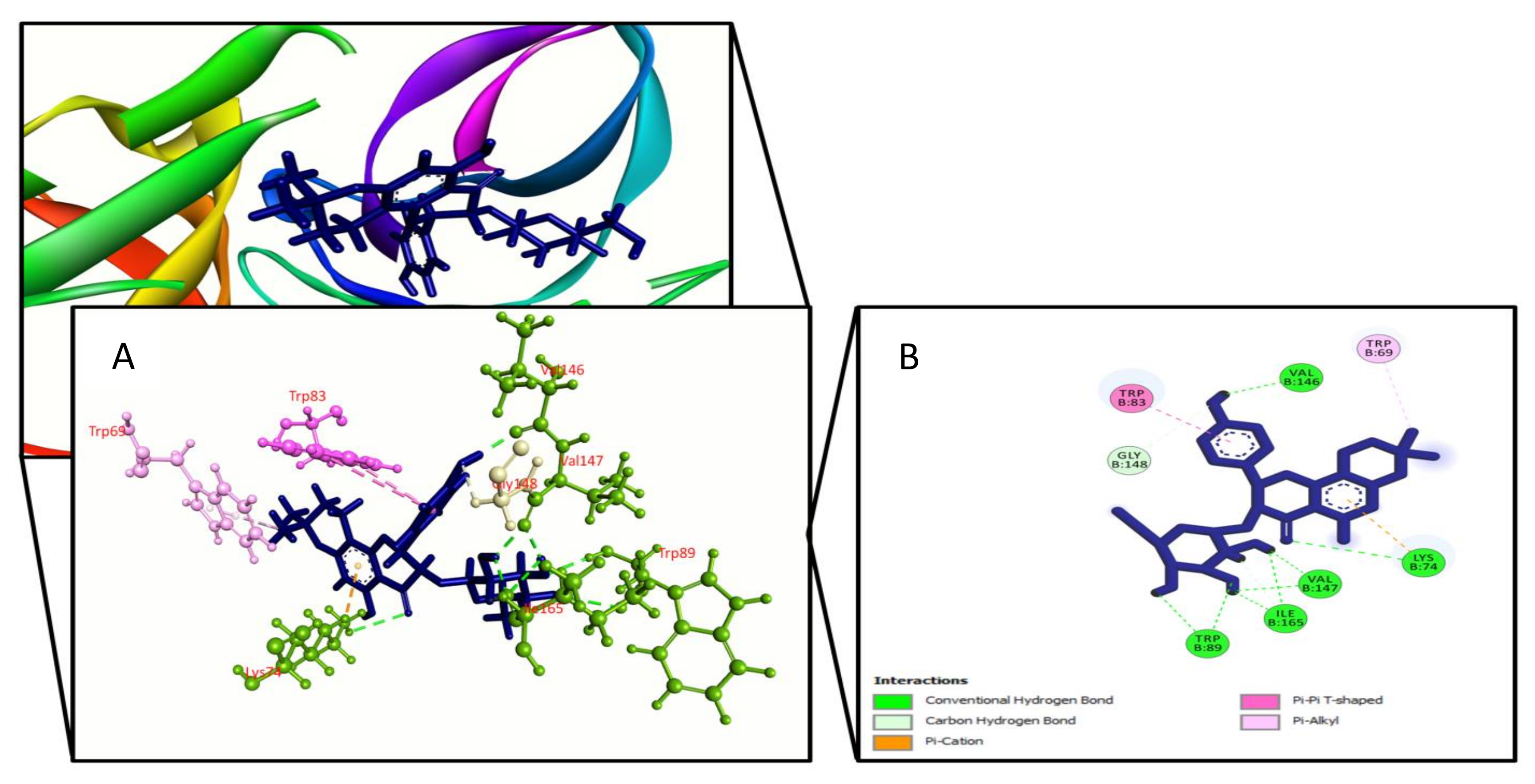
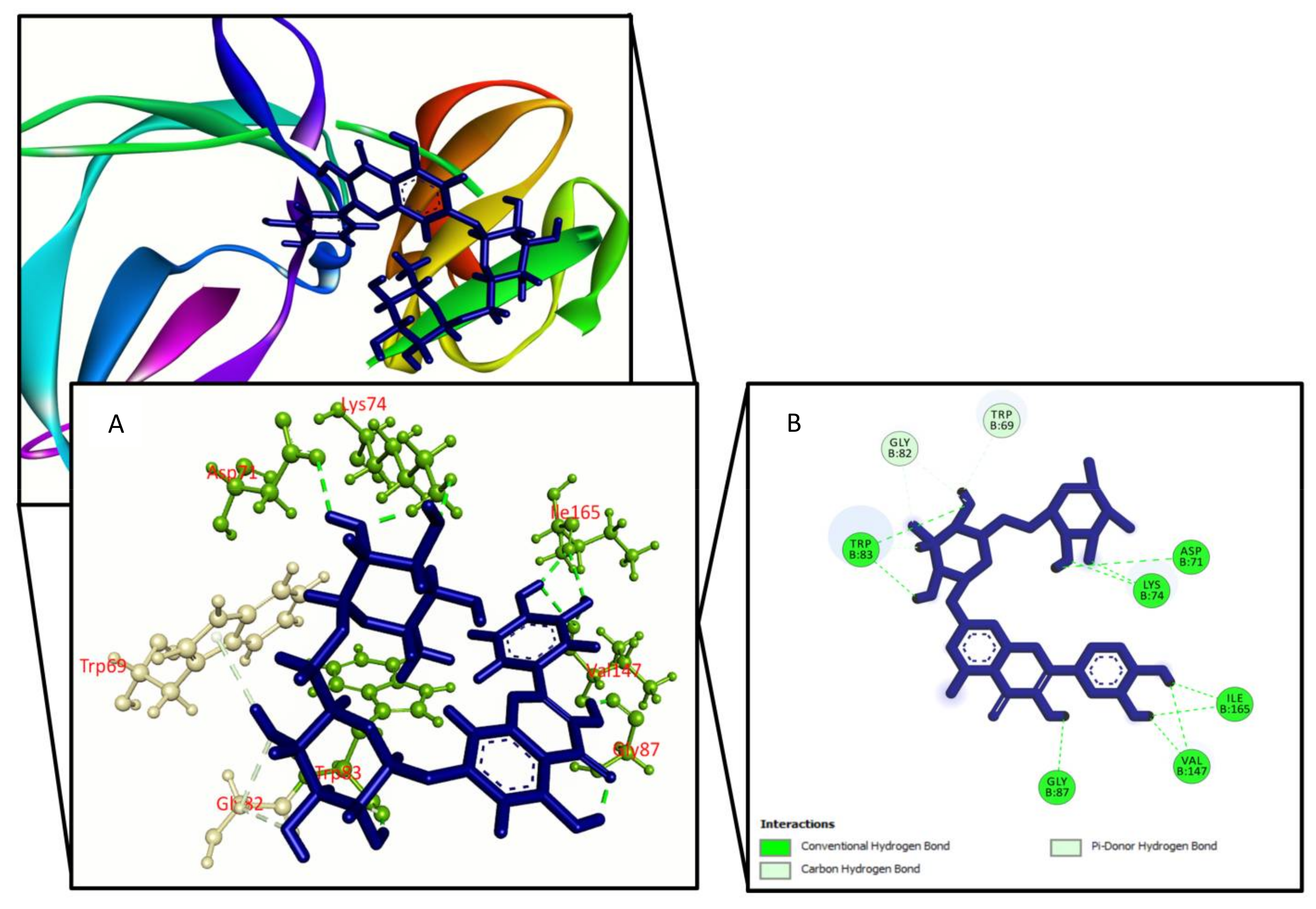

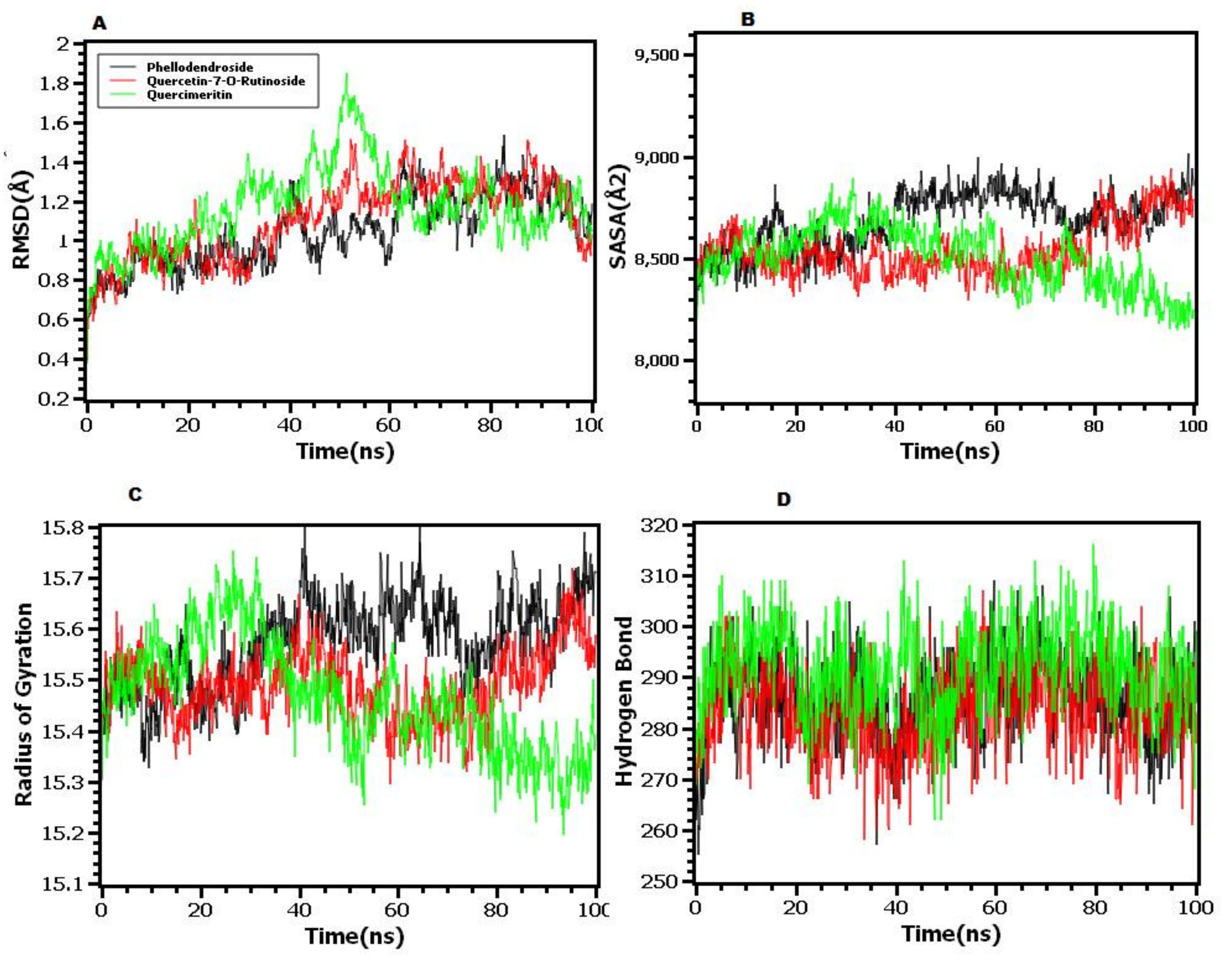
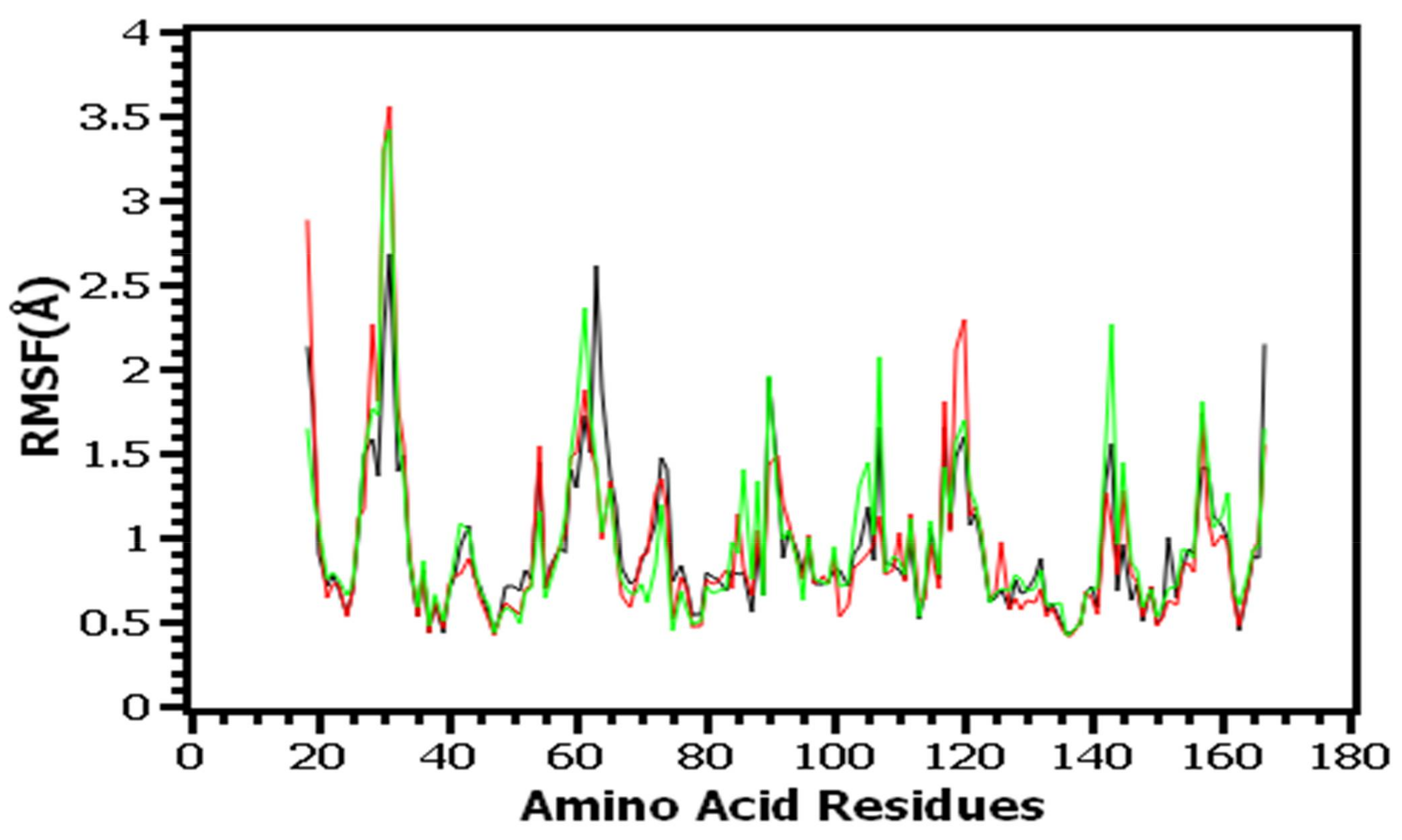
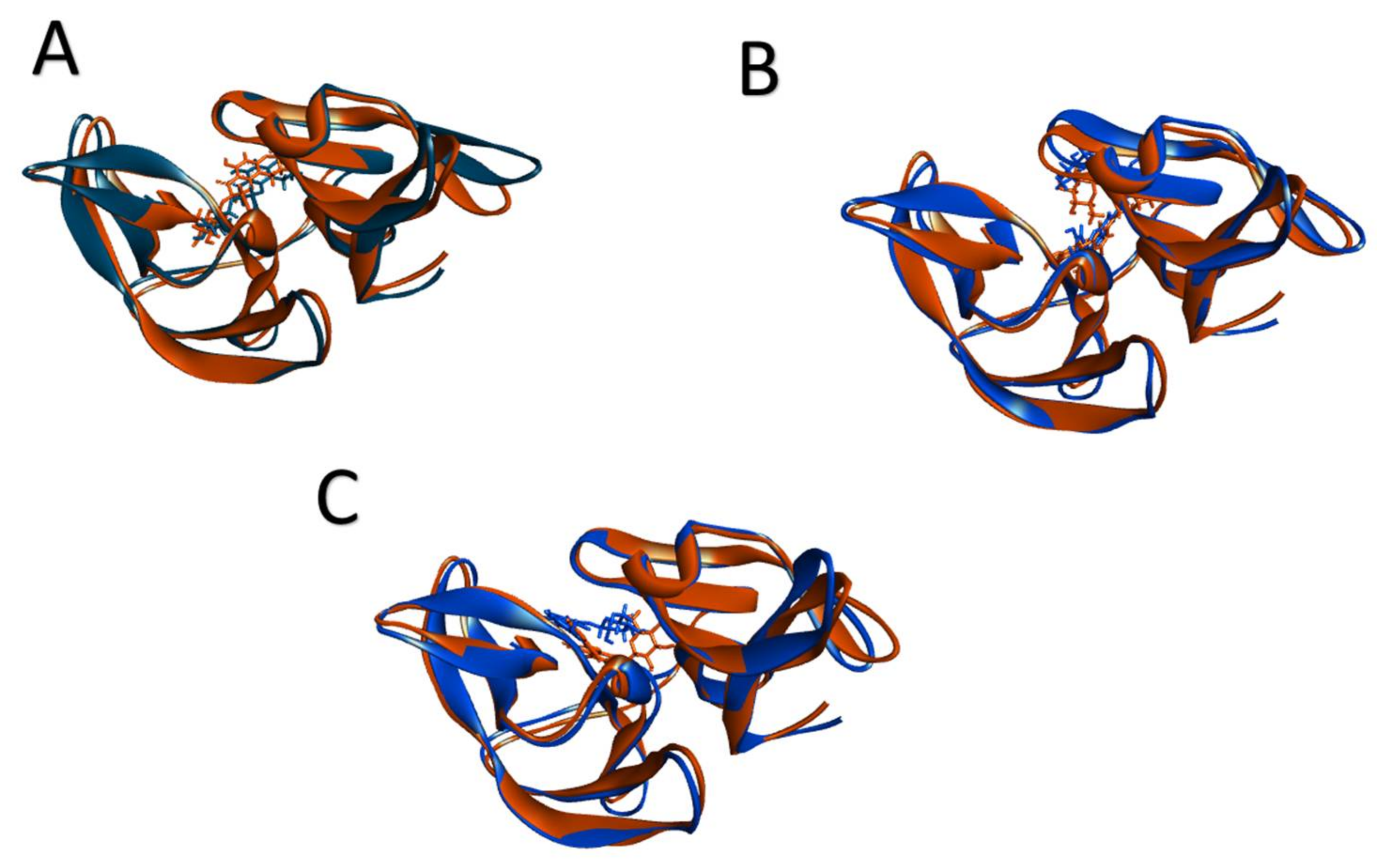
| Compound Name | Docking Score (Kcal/mol) | XP Score (Kcal/mol) | ΔGbind (kcal/mol) | Hydrogen BondInteractions | Hydrophobic Bonds (Pi–Alkyl/Alkyl) | Hydrophobic Bonds (Pi–Pi/Pi–Sigma/Pi–Cation/Pi–Anion/Pi–Amide) | Hydrophobic Bonds (Pi–Sulfur/Carbon–Hydrogen) |
|---|---|---|---|---|---|---|---|
| Rutaecarpine | −4.2 | −3.7 | −39.8 | Trp83 | Leu76 | Ile165 | - |
| Sesamin | −5.3 | −4 | −45.1 | Lys74, Leu149 | Leu76 | - | Leu149, Ala164 |
| Choerospondin | −6.3 | −5.1 | −47.9 | Lys74, Glu88, Leu149, Asn152, Ala164 | Leu76 | Trp83, Ile165 | - |
| Evodiamine | −4.7 | −39 | Leu85 | Leu76, Trp83, Leu85 | Glu88 | Leu85, Gly87, Val146 | |
| −3.1 | |||||||
| Narirutin | −5 | −3.6 | −30.7 | Lys74, Trp83, Leu85, Gly87, Glu88, Asn152 | - | - | Leu85, Glu86 |
| Angustidine | −4.6 | −6 | −45.1 | Trp83, Leu149 | Leu76, Ala166 | - | Gly87 |
| Forsythoside A | −6 | −5.8 | −34.6 | Glu43, Lys74, Glu86, Gly87, Glu88, Val146 | Val147 | - | Trp83 |
| Luteone | −5.8 | −5.9 | −51.1 | Lys74, Leu85, Asn152, Asn167 | - | Trp83, Ile165 | Val147 |
| Quercimeritrin | −5.2 | −6 | −59.5 | Lys74, Trp83, Leu85, Glu88, Asn152, Asn167 | Lys74, Leu76 | - | Trp83, Leu85 |
| Hydroxytanshinone | −5.1 | −5.4 | −49.6 | Trp83, Gly87, Leu149 | Leu76, Ala164 | Ile165 | Asn152 |
| Methylophiopogonanone A | −5 | −5.1 | −49.1 | Trp83, Asn152, Ala164 | Leu76 | Ile165 | Gly148, Ile165 |
| Tanshinlactone | −4.6 | −3.5 | −40.2 | Trp83 | Leu76, Ala164 | - | Glu88, Gly148 |
| Asarinin | −5.3 | −4.2 | −35.9 | Lys74, Leu149, Asn167 | Lys74, Leu76 | - | Trp83, Gly148, Ala164, Ile165 |
| Piperitylhonokiol | −4.6 | −4.7 | −52.5 | Leu149, Ala164, Ile165 | Trp69, Lys74, Leu76 | Lys74, Trp83, Ile165 | - |
| Sanjoinine B | −4.3 | −4.7 | −48.3 | Glu88, Asn167 | Trp83, Ala166 | - | Ile165, Ala166 |
| Sanjoinine D | −3.7 | −5 | −48.4 | Lys74, Glu88 | Trp83, Ala166 | - | Glu88 |
| Scutianine D | −3.4 | −5.1 | −44.4 | Lys74, Asn167 | Trp83 | Lys74, Trp83 | Trp83, Ile165, Ala166 |
| Scutianine C | −4.1 | −4.6 | −42.9 | Lys74, Asn167 | Ala166 | Glu88, Lys90 | Ala166 |
| 6’’-O-Acetylliquiritin | −5.2 | −5.4 | −52.2 | Lys74, Glu88, Asn152 | Lys74, Leu76 | Lys74, Trp83, Ile165 | Glu88, Gly148 |
| Phellodendroside | −5.1 | −6.1 | −63 | Lys74, Trp89, Val146, Val147, Ile165 | Trp69 | Lys74, Trp83 | Gly148, Ile165 |
| Quercetin-7-O-Rutinoside | −5 | −5.9 | −54.1 | Asp71, Lys74, Trp83, Gly87, Val147, Ile165 | - | - | Trp69, Gly82 |
| (S)-Suspensaside | −4.7 | −3.5 | −28.2 | Lys74, Trp83, Gly87, Glu88, Asn167 | - | - | Trp69, Leu85, Glu86, Glu88, Val147, Gly148 |
| Paeonidanin B | −5.6 | −5.3 | −47.1 | Lys74, Leu85, Gly87, Asn152, Ala164, Asn167 | Lys74, Leu76 | - | Leu85, Gly87, Gly148 |
| Phellamuretin | −5.5 | −5.8 | −42.9 | Lys74, Trp89, Lys90, Asn167 | Ala166 | Glu88 | Trp83 |
| Nortanshinone | −6.1 | −5.3 | −44.1 | Trp83, Leu149, Asn167 | Leu76, Ala164 | Ile165 | Leu85 |
| Sec-O-Glucosylhamaudol | −4.4 | −4.6 | −45.7 | Trp83, Leu85, Leu149 | Leu76, Ala164 | Ile165 | Trp83, Leu85, Gly148 |
| Benzoyloxypaeoniflorin | −4.9 | −5.5 | −37.8 | Lys74, Trp83, Gly87, Asn152 | Lys74, Leu76, Ala166 | Ile165 | - |
| Control | −5.1 | −5.4 | −51.3 | Phe130, Val72Arg54, His51 | Leu128 | - | - |
| Parameter | Phellodendroside | Quercimeritrin | Quercetin-7-O-Rutinoside |
|---|---|---|---|
| Molecular weight | 518.51g/mol | 464.38g/mol | 610.52g/mol |
| H bond acceptor | 11 | 12 | 16 |
| H bond donor | 6 | 8 | 10 |
| CYP2D6 substrate | No | No | No |
| CYP3A4 substrate | No | No | No |
| CYP1A2 inhibitor | No | No | No |
| CYP2C19 inhibitor | No | No | No |
| CYP2C9 inhibitor | No | No | No |
| CYP2D6 inhibitor | No | No | No |
| CYP3A4 inhibitor | No | No | No |
| AMES toxicity | No | No | No |
| Oral rat acute toxicity (LD50) | 2.957 (mol/kg) | 2.20 (mol/kg) | 2.53 (mol/kg) |
Publisher’s Note: MDPI stays neutral with regard to jurisdictional claims in published maps and institutional affiliations. |
© 2022 by the authors. Licensee MDPI, Basel, Switzerland. This article is an open access article distributed under the terms and conditions of the Creative Commons Attribution (CC BY) license (https://creativecommons.org/licenses/by/4.0/).
Share and Cite
Shimu, M.S.S.; Mahmud, S.; Tallei, T.E.; Sami, S.A.; Adam, A.A.; Acharjee, U.K.; Paul, G.K.; Emran, T.B.; Zaman, S.; Uddin, M.S.; et al. Phytochemical Compound Screening to Identify Novel Small Molecules against Dengue Virus: A Docking and Dynamics Study. Molecules 2022, 27, 653. https://doi.org/10.3390/molecules27030653
Shimu MSS, Mahmud S, Tallei TE, Sami SA, Adam AA, Acharjee UK, Paul GK, Emran TB, Zaman S, Uddin MS, et al. Phytochemical Compound Screening to Identify Novel Small Molecules against Dengue Virus: A Docking and Dynamics Study. Molecules. 2022; 27(3):653. https://doi.org/10.3390/molecules27030653
Chicago/Turabian StyleShimu, Mst. Sharmin Sultana, Shafi Mahmud, Trina Ekwati Tallei, Saad Ahmed Sami, Ahmad Akroman Adam, Uzzal Kumar Acharjee, Gobindo Kumar Paul, Talha Bin Emran, Shahriar Zaman, Md. Salah Uddin, and et al. 2022. "Phytochemical Compound Screening to Identify Novel Small Molecules against Dengue Virus: A Docking and Dynamics Study" Molecules 27, no. 3: 653. https://doi.org/10.3390/molecules27030653
APA StyleShimu, M. S. S., Mahmud, S., Tallei, T. E., Sami, S. A., Adam, A. A., Acharjee, U. K., Paul, G. K., Emran, T. B., Zaman, S., Uddin, M. S., Saleh, M. A., Alshehri, S., Ghoneim, M. M., Alruwali, M., Obaidullah, A. J., Jui, N. R., Kim, J., & Kim, B. (2022). Phytochemical Compound Screening to Identify Novel Small Molecules against Dengue Virus: A Docking and Dynamics Study. Molecules, 27(3), 653. https://doi.org/10.3390/molecules27030653










